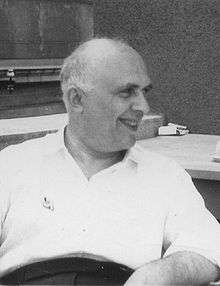Vitaly Halberstadt
Vitaly Halberstadt (20 March 1903, Odessa – 25 October 1967, Paris) was a French chess player, theorist, tactician, problemist, and, above all, a noted endgame study composer.[1]

Born in Odessa, in the Kherson Governorate of the Russian Empire (present-day Ukraine), he emigrated to France after the Russian Civil War.
Chess games
| Year | Placement | Competition or location | Victor of year |
|---|---|---|---|
| 1925 | 1st place (shared with Abraham Baratz) | Paris City Chess Championship | Halberstadt and Baratz |
| 1926 | 2nd place | Leon Schwartzmann | |
| 5-6th places | Hyères | Abraham Baratz | |
| 1st place (shared with Peter Potemkine) | Paris | Halberstadt and Potemkine | |
| 1927 | 5-7th places | Paris City Chess Championship | Abraham Baratz |
| 1928 | 10-11th places | ||
| 1st-3rd places (tied with Marcel Duchamp and J.J. O'Hanlon) | Hyères | Halberstadt, Duchamp and O'Hanlon | |
| 1930 | 8th place | Paris City Chess Championship | Josef Cukierman |
| 1931 | 6th place | Eugene Znosko-Borovsky | |
| 1932 | 3rd place | Oscar Blum | |
| 1938 | 9th | Paris (L'Echiquier) | Baldur Hoenlinger |
Publications
In 1932, Halberstadt published with Marcel Duchamp "L'Opposition et les cases conjugées sont réconciliées", a chess manual dedicated to several special end-game problems, for which Duchamp designed the layout and cover.[3] In this book, Duchamp and Halberstadt addressed the complication of the so-called "heterodox opposition", which is a precisely organized endgame that involved two kings and a handful of pawns.[4] This concept has established a figure of immobilized reversibility between two subjective positions and two players.[4] Within a condition where only two kings remain,[5] the duo described the move in the following manner:
The king 'may act in such a way as to suggest he has completely lost interest in winning the game. Then the other king, if he is a true sovereign, can give the appearance of being even less interested.' Until one of them provokes the other into a blunder.[6]
Halberstadt was also the author of "Curiosités tactiques des finales" (1954).
References
- "Halberstadt". heritageechecsfra.free.fr.
- "Amsterdam (NED-ch10th) 1938". Archived from the original on 2010-12-15. Retrieved 2010-12-15.
- Art, Philadelphia Museum of. "Philadelphia Museum of Art - Archives : Finding Aids". www.philamuseum.org.
- Joselit, David (2001). Infinite Regress: Marcel Duchamp, 1910-1941. Cambridge: MIT Press. p. 174. ISBN 9780262600385.
- Witham, Larry (2013). Picasso and the Chess Player: Pablo Picasso, Marcel Duchamp, and the Battle for the Soul of Modern Art. Hanover: UPNE. p. 327. ISBN 9781611682533.
- McEvilley, Thomas (1999). Sculpture in the Age of Doubt. New York: Allworth Press. pp. 56. ISBN 1581150237.
External links
- Vitaly Halberstadt player profile and games at Chessgames.com